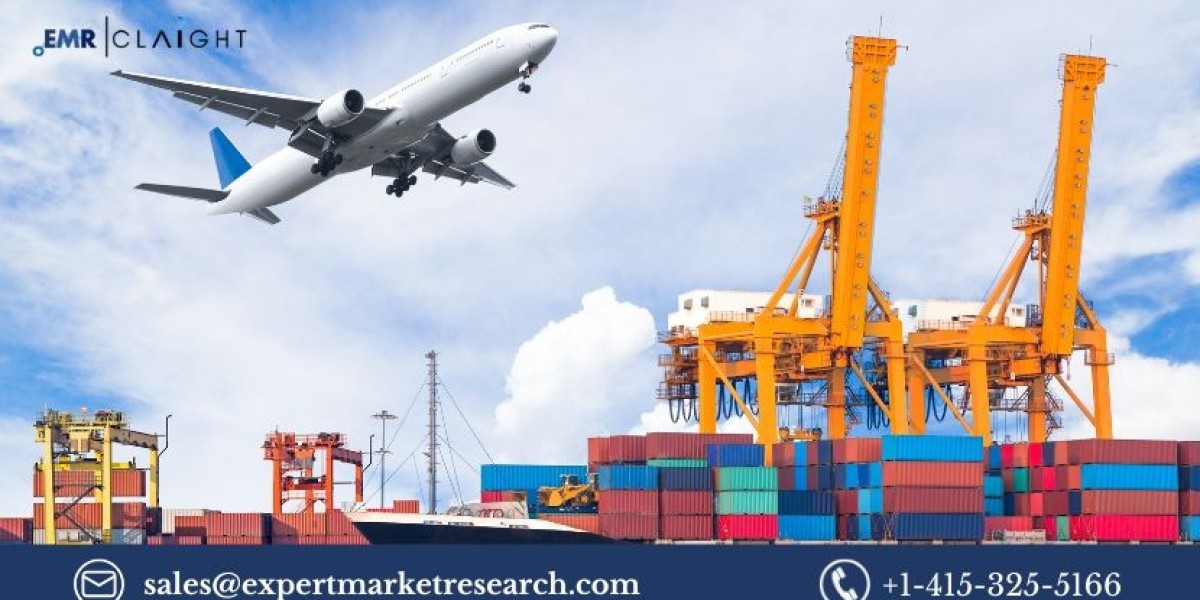The air freight market has experienced significant growth in recent years, driven primarily by the rise in e-commerce and the increasing need for time-sensitive shipping options. As businesses continue to focus on fast and reliable deliveries, air freight has become a critical component of the logistics industry. The global air freight market reached a volume of nearly 109.67 MMT in 2024, and it is projected to grow at a compound annual growth rate (CAGR) of 12.00% during the forecast period from 2025 to 2034, reaching a volume of 340.62 MMT by 2034. This growth is fueled by several factors, including the globalization of trade, the demand for same-day and next-day delivery services, and the need for efficient logistics solutions.
This article explores the air freight market in detail, including its overview, market size and share, key dynamics and trends, growth prospects, opportunities, challenges, and competitive landscape.
Overview of the Global Air Freight Market
The air freight market refers to the transportation of goods by aircraft, primarily used for time-sensitive deliveries of high-value or perishable goods. Air freight plays a critical role in global trade, facilitating the rapid movement of goods across borders and ensuring that products reach their destinations in a timely manner. It is considered one of the most reliable and efficient modes of transportation, offering advantages such as speed, safety, and accessibility to remote locations.
With the rise of global e-commerce, the demand for air freight services has increased dramatically. Consumers are increasingly expecting fast deliveries, and businesses are under pressure to meet these expectations, particularly when it comes to high-value goods, electronics, pharmaceuticals, and perishable items. Air freight has proven to be an effective solution for these time-sensitive deliveries, which is one of the key factors driving its growth.
Additionally, the ongoing globalization of trade has contributed to the increasing demand for air freight services. As companies expand their operations internationally, they require efficient logistics solutions to manage cross-border transactions and supply chains. The air freight industry is evolving to meet these demands, with companies offering a wide range of services to cater to different industries and shipment types.
Get a free sample request: https://www.expertmarketresearch.com/reports/air-freight-market/requestsample
Size & Share of the Air Freight Market
The global air freight market was valued at approximately 109.67 million metric tons (MMT) in 2024. The market is expected to grow significantly in the coming years, driven by the expanding e-commerce industry and the growing demand for fast and efficient shipping solutions. By 2034, the air freight market is forecasted to reach a volume of 340.62 MMT, reflecting a CAGR of 12.00% during the forecast period of 2025-2034.
The market is dominated by several key regions, with Asia-Pacific (APAC) being the largest market for air freight, followed by Europe and North America. The growth in APAC can be attributed to the region's expanding e-commerce sector, which has led to an increase in demand for fast and reliable shipping options. Additionally, the rise in international trade between countries in the APAC region and the rest of the world has further boosted the need for air freight services.
Europe and North America also represent significant shares of the global air freight market. The European Union (EU) is a key hub for air cargo transportation, while North America is home to major logistics providers, such as United Parcel Service (UPS) and FedEx, that dominate the air freight sector.
Market Dynamics & Trends in the Air Freight Industry
Several key dynamics and trends are shaping the future of the global air freight market. These include technological advancements, evolving consumer preferences, and the growing demand for sustainable logistics solutions.
Surge in E-Commerce and Time-Sensitive Deliveries
One of the primary drivers of the air freight market is the rapid growth of e-commerce. As online shopping becomes more prevalent, consumers increasingly expect fast delivery options. To meet these expectations, businesses are relying more on air freight services for time-sensitive deliveries. This is particularly important for high-value goods, electronics, fashion items, pharmaceuticals, and perishables that require quick transportation.
The rise of same-day and next-day delivery services is one of the key trends in the air freight industry. Companies like Amazon, Alibaba, and other major e-commerce players are investing heavily in air freight capabilities to meet the growing demand for fast deliveries. As a result, air cargo providers are continuously enhancing their services to ensure timely and reliable deliveries.
Globalization of Trade and Cross-Border Transactions
The increasing globalization of trade has contributed significantly to the growth of the air freight market. As companies expand their operations across borders, they require efficient logistics solutions to manage their supply chains and ensure timely delivery of goods. Air freight is a preferred choice for businesses engaged in international trade because of its speed and ability to access markets across the globe.
With international trade continuing to expand, particularly in emerging markets, air freight services are in high demand to facilitate the movement of goods between countries. The growth in cross-border transactions is expected to drive the air freight market's expansion, as companies seek reliable transportation options for their goods.
Technological Advancements and Automation
Technological advancements are playing a crucial role in transforming the air freight industry. Innovations in automation, data analytics, and artificial intelligence (AI) are improving operational efficiency and enhancing customer experience. For example, automation in airports and warehouses helps reduce cargo handling times and increases the speed at which goods are processed and shipped.
Moreover, advanced tracking systems enable customers to monitor the status of their shipments in real-time, ensuring transparency and improving communication between logistics providers and customers. These technologies help businesses and logistics companies improve the accuracy and reliability of their deliveries, further fueling the demand for air freight services.
Sustainability and Green Logistics
As sustainability becomes a top priority for businesses and consumers alike, the air freight industry is under pressure to reduce its environmental impact. Air freight is often seen as an energy-intensive mode of transportation, and efforts to reduce emissions and fuel consumption are becoming increasingly important. Many air freight companies are investing in eco-friendly practices, such as using more fuel-efficient aircraft, optimizing flight routes, and offsetting carbon emissions.
The growing emphasis on sustainability is also driving the development of green logistics solutions. Companies are exploring alternative fuels, such as biofuels, and using electric vehicles for last-mile deliveries. These initiatives are not only helping reduce the carbon footprint of air freight but are also meeting the increasing demand for environmentally responsible logistics services.
Growth Drivers of the Air Freight Market
Several key factors are driving the growth of the air freight market, including the rise in e-commerce, the globalization of trade, and technological innovations.
Increasing Demand for Fast Shipping in E-Commerce
The e-commerce boom has significantly increased demand for fast and reliable shipping services. As consumers expect quick delivery times, businesses are relying on air freight to meet their customers' expectations. Same-day and next-day delivery services are becoming the norm, especially for high-value or time-sensitive products. The growing reliance on air freight for e-commerce logistics is a major growth driver for the market.
Expansion of International Trade
The expansion of international trade, particularly in emerging markets, is driving the need for efficient logistics solutions. As countries continue to engage in cross-border trade, businesses require fast and reliable shipping options to move goods across borders. Air freight is an ideal solution for global trade, providing quick delivery and access to international markets.
Rising Consumer Expectations for Fast Delivery
Consumers' growing demand for faster delivery times is pushing businesses to invest in air freight services. Whether it's for same-day delivery or next-day delivery, consumers are willing to pay a premium for faster shipping, especially for products like electronics, luxury items, and pharmaceuticals. This rising demand for quick shipping is a key driver of the air freight market's growth.
Market Opportunities and Challenges in the Air Freight Industry
While the air freight market presents significant opportunities for growth, there are also challenges that companies must address.
Opportunities
E-Commerce Growth: The continued growth of the e-commerce sector presents significant opportunities for air freight providers. As more consumers turn to online shopping, the demand for fast and reliable shipping options will continue to rise, providing a steady stream of business for air freight companies.
Technological Advancements: The integration of advanced technologies, such as AI, automation, and blockchain, presents opportunities for air freight companies to improve efficiency, reduce costs, and enhance customer satisfaction.
Sustainability Initiatives: The growing focus on sustainability presents an opportunity for air freight companies to invest in eco-friendly practices, such as using biofuels, optimizing flight routes, and investing in energy-efficient aircraft.
Challenges
High Fuel Costs: The air freight industry is heavily dependent on fuel, and fluctuations in fuel prices can significantly impact operating costs. Rising fuel prices may challenge air freight companies in maintaining profitability while keeping shipping costs competitive.
Regulatory Compliance: The air freight industry is subject to various regulations related to safety, security, and environmental standards. Companies must navigate these regulations to ensure compliance and avoid costly penalties.
Capacity Constraints: Air freight capacity can be limited, particularly during peak seasons. With increasing demand for fast shipping, companies may face challenges in meeting customer expectations during busy periods.
Competitor Analysis in the Air Freight Market
Several key players dominate the global air freight market, offering a wide range of services to cater to the growing demand for fast and reliable shipping.
Deutsche Post AG
Deutsche Post AG is a leading player in the global air freight market, providing integrated logistics solutions through its subsidiary, DHL Global Forwarding. The company offers a range of air freight services, including express delivery and time-sensitive shipments.
United Parcel Service (UPS)
UPS is one of the largest logistics companies in the world, providing air freight services to businesses and consumers alike. The company's extensive network of air cargo services allows it to cater to a wide range of industries and offer flexible shipping options.
FedEx Corp.
FedEx is a major player in the air freight market, offering international air cargo services for time-sensitive shipments. The company's air freight services are supported by a global network of hubs and fleet of aircraft.
The Emirates Group
The Emirates Group, through its subsidiary Emirates SkyCargo, is a key player in the global air freight market. The company offers air cargo services to destinations around the world, catering to industries such as pharmaceuticals, electronics, and perishables.
Cargolux International Airlines S.A.
Cargolux is a global leader in air freight services, specializing in the transportation of high-value and time-sensitive goods. The company offers a wide range of air cargo services to meet the needs of businesses worldwide.
The air freight market is poised for substantial growth, driven by the rise of e-commerce, the increasing demand for fast shipping services, and the globalization of trade. With a projected CAGR of 12.00%, the market is expected to reach a volume of 340.62 MMT by 2034. The ongoing expansion of international trade, technological advancements, and the increasing focus on sustainability will further contribute to the market's growth. However, challenges such as high fuel costs and regulatory compliance remain. Key players in the industry, such as Deutsche Post AG, UPS, FedEx, and Emirates Group, will continue to play a vital role in shaping the future of the air freight market.
Toy Manufacturers:
https://www.expertmarketresearch.com/articles/top-toys-companies








